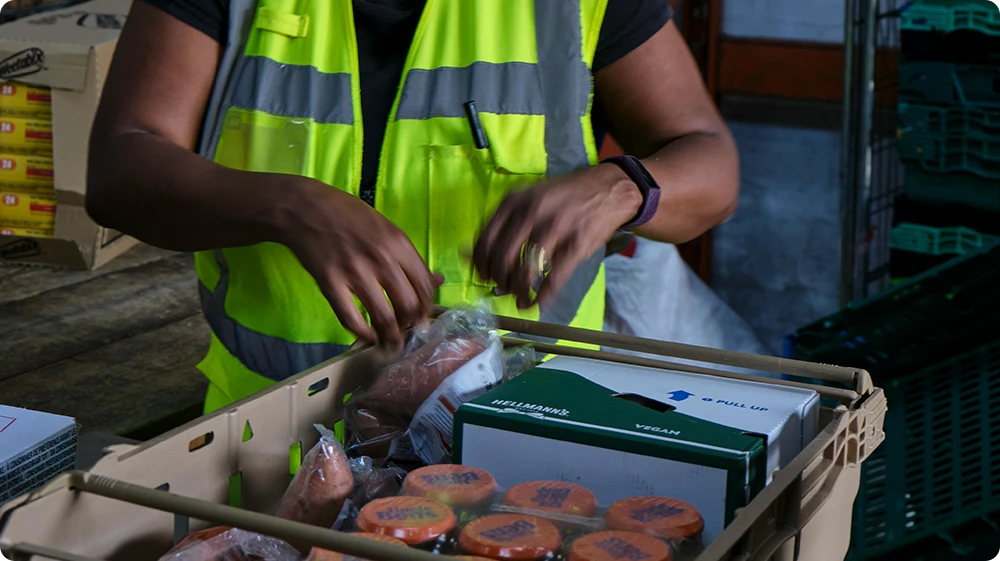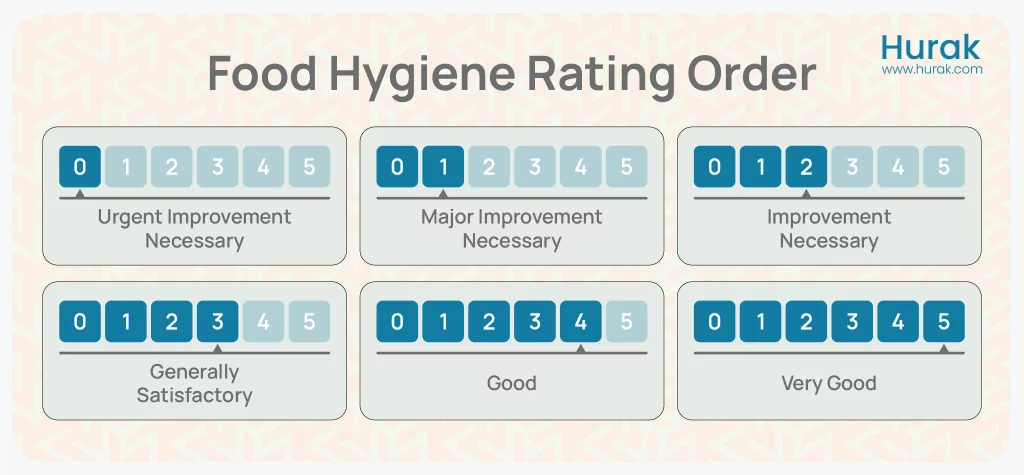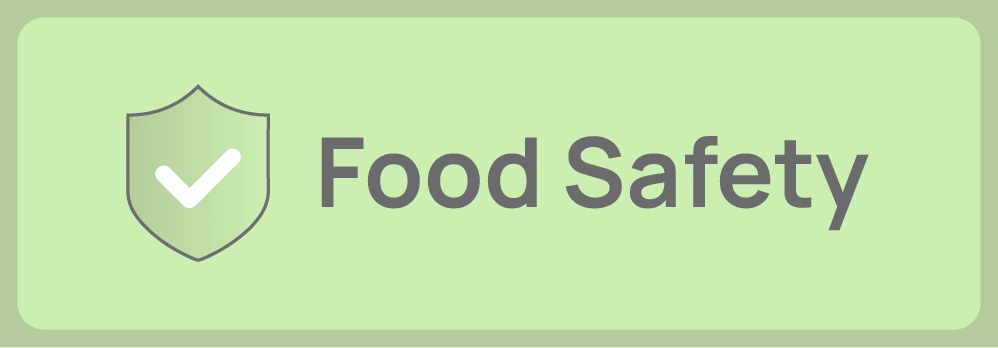When deciding where to eat or buy food, many people first check the business’s food hygiene rating. But what does that rating mean, and how is it decided?
The Food Hygiene Rating Scheme (FHRS) is an initiative by the UK government to check the food safety and hygiene practices of businesses across England. Run by the Food Standards Agency (FSA) in partnership with local authorities, it provides a clear rating, ranging from 0 to 5, based on how well a business complies with food hygiene law.
For food business owners, the rating can influence customer trust, reputation, and even sales. For consumers, it’s a quick way to check that food is being handled safely.
In this article, we’ll explain how the scheme works, what inspectors look for, how to improve your score, and why maintaining a good hygiene rating matters more than ever.
What Is The Food Hygiene Rating Scheme?
The Food Hygiene Rating Scheme (FHRS) is a UK government programme that assesses how well food businesses adhere to hygiene and safety regulations. It applies to places like restaurants, cafes, takeaways, food shops, and even some schools and hospitals. The scheme’s main goal is to help people make safer choices when eating out or buying food. It also encourages businesses to improve their hygiene standards to protect customers.
Each business is inspected by local authority food safety officers who give it a rating from 0 to 5, with 5 meaning very good hygiene and 0 meaning urgent improvement is needed.

How Does The Food Hygiene Rating System Work?
When a food business is inspected, the food safety officer checks how well it follows the law in three key areas:
- Food handling – how it’s prepared, cooked, cooled, stored, and reheated.
- Cleanliness and condition of the premises – this covers the layout, lighting, ventilation, handwashing facilities, and overall cleanliness.
- Management of food safety – whether the business has systems in place to make sure food is safe and whether staff know how to follow them. This includes practices based on HACCP principles.
Each area is assessed, and the business is given a rating that ranges from 0 to 5, based on how well it meets the legal standards:
Ranges Of The Food Hygiene Rating System:
The higher the rating, the better the hygiene practices. If serious problems are identified, the business will receive a lower rating and be required to take immediate action to resolve the issues.

To maintain a high food hygiene rating, it’s essential to follow effective hygiene practices for Food Safety and Food Hygiene, and apply proper cleaning methods, such as the 6 Stages of Cleaning.
Understanding The Food Hygiene Ratings (0 to 5)
The Food Hygiene Rating indicates how well a business adheres to food safety regulations. Here’s what each range means:
Food Hygiene Rating “5” Indicates – Very good
The business is fully compliant with food hygiene law. Clean premises, safe food handling, and strong safety systems are all in place.
Food Hygiene Rating “4” Indicates – Good
Generally high standards. Minor improvements may be needed, but nothing major.
Food Hygiene Rating “3” Indicates – Generally satisfactory
The basics are covered, but there’s room for improvement in one or more areas.
Food Hygiene Rating “2” Indicates – Improvement necessary
Several issues need to be addressed to meet the required hygiene standards.
Food Hygiene Rating “1” Indicates – Major improvement necessary
Serious issues exist. The business must take urgent steps to improve food hygiene.
Food Hygiene Rating “0” Indicates – Urgent improvement necessary
The hygiene conditions are very poor. There’s a serious risk to public health, and immediate action is required.
These ratings enable customers to make informed choices and encourage businesses to maintain safe and hygienic practices.
FHRS Ratings Breakdown (UK)
To give you a clearer picture of how food businesses are performing across the UK, let’s look at the approximate percentage of food businessesthat fall into each category:
| Rating | Meaning | Approximate % of Businesses |
| 5 | Hygiene standards are excellent | 47% |
| 4 | Hygiene standards are good | 36% |
| 3 | Hygiene standards are generally satisfactory | 10% |
| 2 | Some improvement is necessary | 4% |
| 1 | Major improvement is necessary | 2% |
| 0 | Urgent improvement is required | 1% |
Note: These figures are approximate and compiled from publicly available industry sources, such as the Food Standards Agency. Percentages may vary slightly depending on the region and the time of reporting.
Who Carries Out The Inspection?
Food hygiene ratings are given by a food safety officer from the local authority.
Local authority food safety officers are responsible for inspecting premises to assess how well a business is complying with food hygiene laws. Their role is to ensure that food sold or served to the public is safe and that businesses comply with the required standards.
Most inspections are unannounced, offering an accurate picture of day-to-day food safety practices. During the visit, the officer checks records, observes practices, and examines the condition of the premises. Their findings are then used to assign a food hygiene rating from 0 to 5.
Key Areas Inspected
During the inspection, officers focus on:
- Food handling: Preparation, cooking, cooling, storage, and reheating practices.
- Cleanliness and condition: Premises cleanliness, layout, lighting, ventilation, and hygiene facilities.
- Management of food safety: Systems like HACCP, staff training, and ongoing safety checks.
Each of these areas contributes to the overall hygiene rating.
How Often Are Inspections Done?
Food hygiene inspections are typically conducted by local authorities at regular intervals, based on the risk level of the business. Higher-risk establishments, such as those handling high-risk food or serving vulnerable populations, are inspected more frequently than lower-risk ones, like small retailers or cafes.
- High-risk businesses (such as restaurants, takeaways, and catering services) are usually inspected every 6 to 12 months.
- Medium-risk businesses (like convenience stores) might be inspected every 1 to 2 years.
- Low-risk businesses (such as food wholesalers or manufacturers) may have inspections every 2 to 3 years or longer.
If a business receives a low rating, local authorities often conduct follow-up visits to check whether necessary improvements have been made. Businesses are typically required to address serious hygiene issues within a specified timeframe, depending on the severity of the problems identified during the inspection.
Is Displaying The Food Hygiene Rating Certificate Mandatory, And What If You Are Not Happy With The Certificate?
Is Displaying The Rating Mandatory?
The requirement to display a food hygiene rating varies across the UK:
- England: Displaying the food hygiene rating is voluntary. While businesses are encouraged to display their rating, there is no legal obligation to do so.
- Wales: Since November 2013, it’s been a legal requirement for food businesses to display their food hygiene rating sticker in a prominent place, such as at the entrance to their premises
- Northern Ireland: Since October 2016, food businesses have been legally required to display their food hygiene rating sticker in a prominent place, like the front door, entrance, or window of the business.

What If You Are Not Happy With The Rating?
If you believe your food hygiene rating does not accurately reflect your business’s standards:
- Request a Re-Inspection: You can apply for a re-inspection after making improvements. Note that some local authorities may charge a fee for this service.
- Appeal the Rating: If you think the rating is unfair, you have the right to appeal. The process varies by local authority, so it’s advisable to contact them directly for guidance.
Why A High Food Hygiene Rating Matters
A high food hygiene rating is important for several reasons:
- Legal Compliance: A strong rating shows that your business meets food hygiene regulations, helping you avoid fines, closures, or legal action from health authorities.
- Public Health Protection: Good hygiene reduces the risk of foodborne illnesses and protects customers from contamination or allergic reactions.
- Customer Trust: A visible high rating reassures customers that your business takes food safety seriously, encouraging loyalty and repeat visits.
- Competitive Advantage: Many people check hygiene ratings before deciding where to eat or shop. A high score can give you a competitive edge.
- Business Reputation: Maintaining high standards protects your brand image and reduces the risk of negative reviews or complaints.
- Staff Morale: A clean, well-managed workplace improves working conditions, motivates staff, and supports better service delivery.
Overall, a high rating helps establish a successful and trustworthy food business.
How To Improve Your Food Hygiene Rating
Improving your rating involves focusing on key areas inspectors assess and acting on feedback from inspections. Here are some practical steps:
- Keep Premises Clean: Regular cleaning routines, like following the 6 stages of cleaning, help maintain hygiene and reduce contamination risks.
- Train Staff Thoroughly: Ensure everyone knows proper food handling, handwashing, and cross-contamination prevention techniques.
- Maintain Records: Keep accurate logs of temperature checks, cleaning schedules, and supplier details to demonstrate control of food safety.
- Fix Facility Issues Promptly: Address problems with ventilation, lighting, or pest control to keep the environment safe and compliant.
- Review Food Safety Systems: Regularly update your food safety plan, ideally based on HACCP principles, to stay prepared for inspections and prevent issues.
Small, ongoing improvements can boost your rating and help protect your customers and business reputation.
Conclusion
Understanding the Food Hygiene Rating Scheme is vital for both food businesses and customers. A good rating not only helps build trust and protect public health but also supports your business success. By keeping premises clean, training staff, and maintaining strong food safety systems, you can improve and maintain a high hygiene rating.
Want to take your food safety knowledge to the next level?
Check out these certified courses to help you stay compliant and confident in your food handling skills:
- Food Safety Level 2 – Essential training for food handlers to understand hygiene best practices.
- HACCP Awareness – Learn the principles of hazard analysis and critical control points to manage food safety effectively.
- Allergen Awareness – Understand how to manage allergenic risks and keep customers safe.
FAQs
What is the Food Hygiene Rating Scheme?
The Food Hygiene Rating Scheme (FHRS) is a UK government initiative run by the Food Standards Agency. It scores food businesses from 0 to 5 based on their hygiene practices, enabling customers to make informed choices about where to eat or purchase food.
What is the range of food hygiene ratings in the UK?
The range of food hygiene ratings goes from 0 to 5:
- 0 – Urgent improvement necessary
- 1 – Major improvement necessary
- 2 – Improvement necessary
- 3 – Generally satisfactory
- 4 – Good
- 5 – Very good (often called a 5 star hygiene rating)
What does a food hygiene rating 5 mean?
A food hygiene rating 5 means the business has very good hygiene standards and fully complies with UK food safety laws. This is the highest rating and is often referred to as a 5 star hygiene rating.
What does a food hygiene rating 4 mean?
A food hygiene rating 4 indicates that the business has good hygiene standards with only minor issues. It means the premises are clean and safety systems are mostly effective.
What does a food hygiene rating 3 mean?
A food hygiene rating 3 means the business is generally satisfactory. It meets basic legal hygiene requirements but may need improvements in one or more areas.
What does a food hygiene rating 2 mean?
A food hygiene rating 2 shows that improvement is necessary. Several problems were identified during the inspection that must be addressed to meet legal food hygiene standards.
What does a food hygiene rating 1 mean?
A food hygiene rating 1 means major improvement is necessary. The business may have poor cleaning routines, inadequate food safety management, or other significant hygiene concerns.
What does a food hygiene rating 0 mean?
A food hygiene rating 0 means urgent improvement is needed. This is the lowest possible rating, indicating serious issues that could pose a risk to public health. The business is often re-inspected quickly after receiving this score.
Are food hygiene ratings in the correct order from 0 to 5?
Yes, food hygiene ratings are listed in order from 0 (worst) to 5 (best). Each level reflects the business’s level of compliance with food safety and hygiene laws, with 5 being excellent and 0 meaning urgent action is needed.




